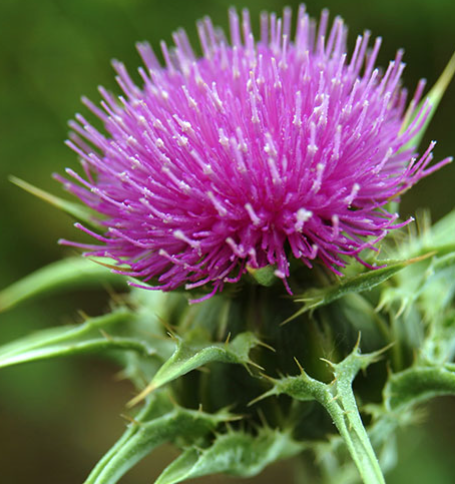Milk thistle 化学特性,用途語,生産方法
-
説明
Thistle, weedy species of Cirsium, Carduus, Echinops, Sonchus, and other plant genera of the family Asteraceae. The word thistle most often refers to prickly-leaved species of Carduus and Cirsium, which have dense heads of small, usually pink or purple flowers. Plants of the genus Carduus, sometimes called plumeless thistles, have spiny stems and flower heads without ray flowers.
Milk thistle is native to Europe and was introduced into North America by early colonists. Milk thistle is found throughout the eastern United States, California, South America, Africa, Australia, and Asia. The terms “milk thistle” and “silymarin” are often used interchangeably. Milk thistle is a plant named for the white veins on its large prickly leaves. Shiny green leaves have distinct white marbling patterns, with spines on leaf edges and stems. In April-October, pink-purple flower heads, with broad, spiny bracts at their bases, appear singly at stem ends. Reproduces via seeds that persist in soil at least 9 years.Historically, people have used milk thistle for liver disorders and gallbladder problems. Milk thistle is promoted as a dietary supplement for hepatitis, cirrhosis, jaundice, diabetes, indigestion, and other conditions.
-
利点
Milk thistle (Silybum marianum) has been used for 2,000 years as an herbal remedy for a variety of ailments, particularly liver, kidney, and gall bladder problems. Several scientific studies suggest that substances in milk thistle (especially a flavonoid called silymarin) protect the liver from toxins, including certain drugs, such as acetaminophen (Tylenol), which can cause liver damage in high doses. Silymarin has antioxidant and anti-inflammatory properties. And it may help the liver repair itself by growing new cells. Although a number of animal studies demonstrate that milk thistle can be helpful in protecting the liver, results in human studies are mixed.
Milk thistle 生産企業
Global(6)Suppliers
-
Shanghai Hao Zhun Biological Technology Co., Ltd.
電話番号 --
電子メール info@zzsrm.com
-
Greater Khingan Range lingebei Psychrophile Polytron Technologies Inc
電話番号 --
電子メール
-
Xi'an Keshuo Biotechnology Co., Ltd.
電話番号 --
電子メール honggezhao776001@yahoo.com
-
Xi'an Sanwei Bio-technology Co., Ltd.
電話番号 --
電子メール bingzhongle@163.com
-
Stem Trade and Industry Limited, Shaanxi
電話番号 --
電子メール hqgm@hqgm.com
-
Huzhou N.B.C Biological Material Co., Ltd
電話番号 --
電子メール info@sm-nbc.com
1of2